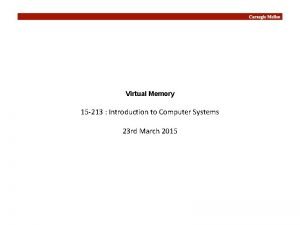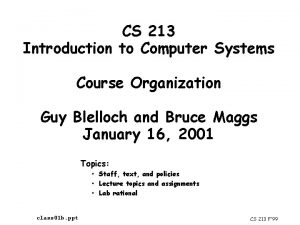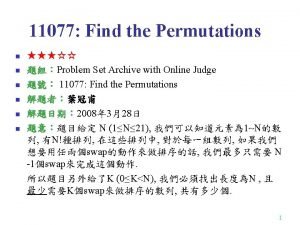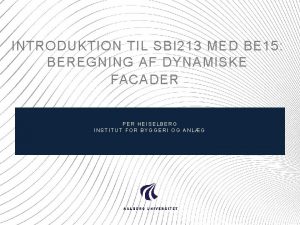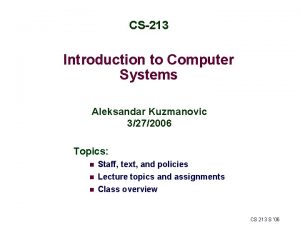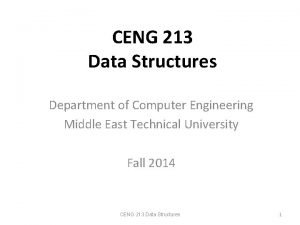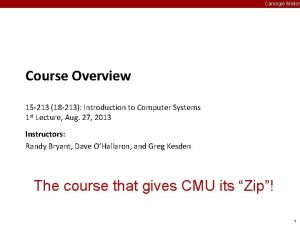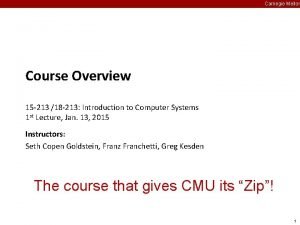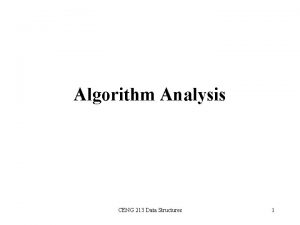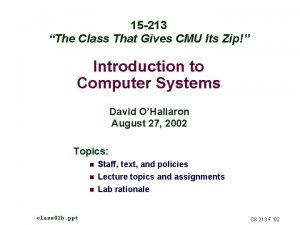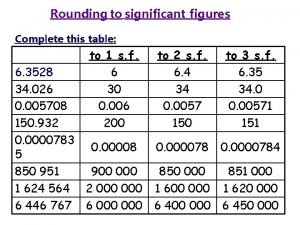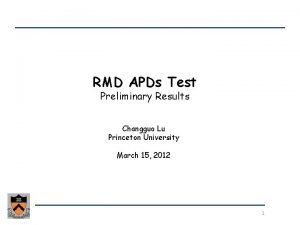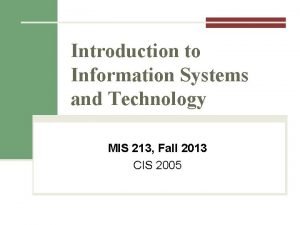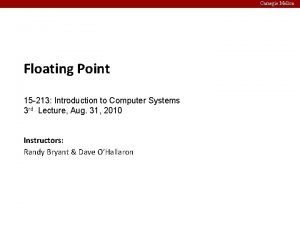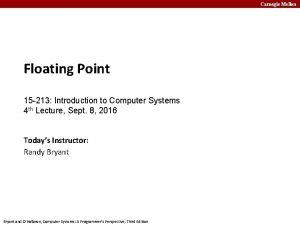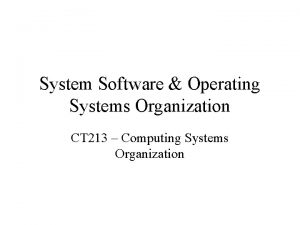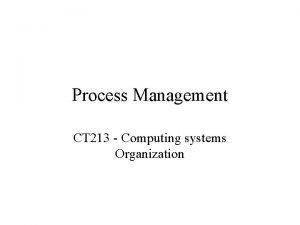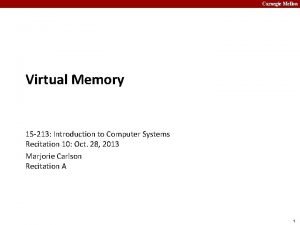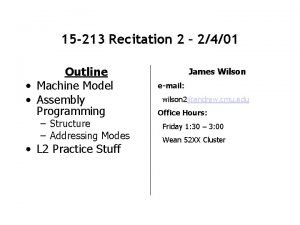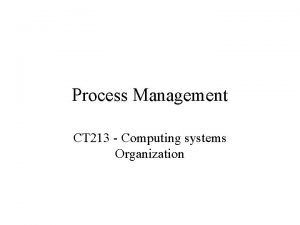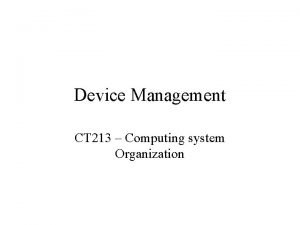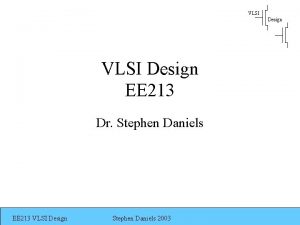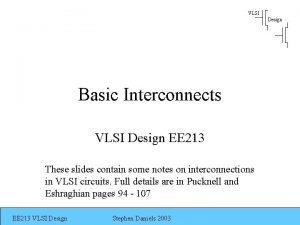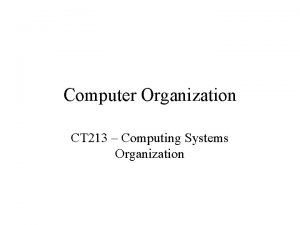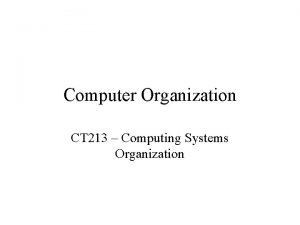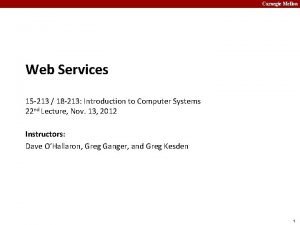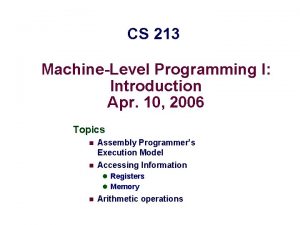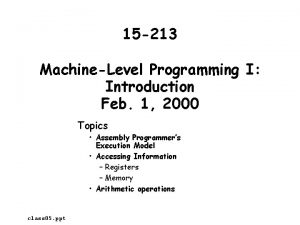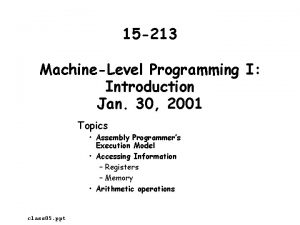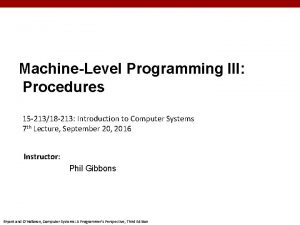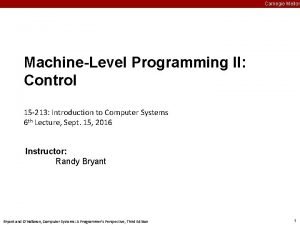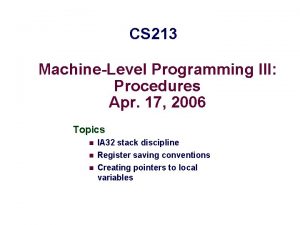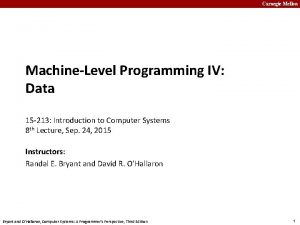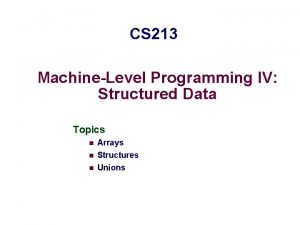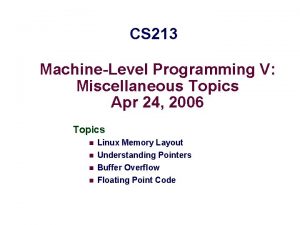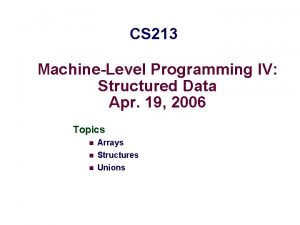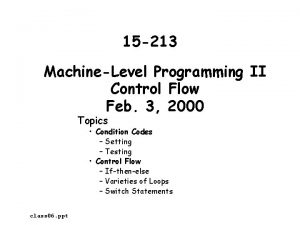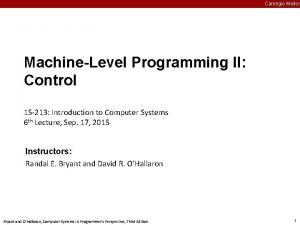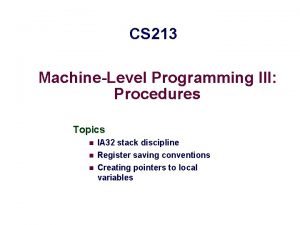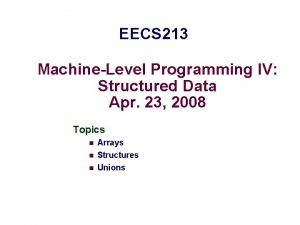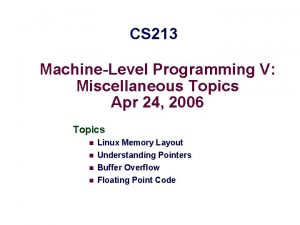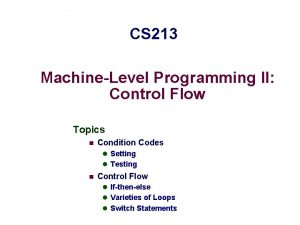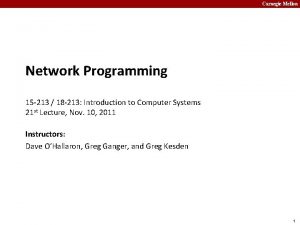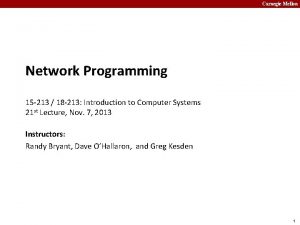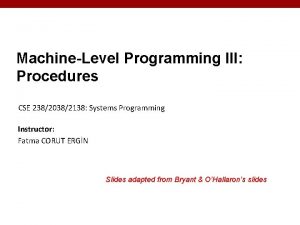15 213 MachineLevel Programming I Introduction January 29

















![Simple Addressing Modes Normal (R) Mem[Reg[R]] • Register R specifies memory address movl (%ecx), Simple Addressing Modes Normal (R) Mem[Reg[R]] • Register R specifies memory address movl (%ecx),](https://slidetodoc.com/presentation_image_h/32e72ba677f93f97156c8c79ec91afb7/image-18.jpg)


![Indexed Addressing Modes Most General Form D(Rb, Ri, S) Mem[Reg[Rb]+S*Reg[Ri]+ D] • D: Constant Indexed Addressing Modes Most General Form D(Rb, Ri, S) Mem[Reg[Rb]+S*Reg[Ri]+ D] • D: Constant](https://slidetodoc.com/presentation_image_h/32e72ba677f93f97156c8c79ec91afb7/image-21.jpg)











- Slides: 32

15 -213 Machine-Level Programming I: Introduction January 29, 2002 Topics • Assembly Programmer’s Execution Model • Accessing Information – Registers – Memory • Arithmetic operations class 05. ppt

IA 32 Processors Totally Dominate Computer Market Evolutionary Design • Starting in 1978 with 8086 • Added more features as time goes on • Still support old features, although obsolete Complex Instruction Set Computer (CISC) • Many different instructions with many different formats – But, only small subset encountered with Linux programs • Hard to match performance of Reduced Instruction Set Computers (RISC) • But, Intel has done just that! class 05. ppt – 2– 15 -213 S’ 02 (Based On CS 213 F’ 01)

X 86 Evolution: Programmer’s View Name 8086 Date Transistors 1978 29 K • 16 -bit processor. Basis for IBM PC & DOS • Limited to 1 MB address space. DOS only gives you 640 K 80286 1982 134 K • Added elaborate, but not very useful, addressing scheme • Basis for IBM PC-AT and Windows 386 1985 275 K • Extended to 32 bits. Added “flat addressing” • Capable of running Unix • Linux/gcc uses no instructions introduced in later models 486 1989 1. 9 M Pentium 1993 3. 1 M class 05. ppt – 3– 15 -213 S’ 02 (Based On CS 213 F’ 01)

X 86 Evolution: Programmer’s View Name Date Transistors Pentium/MMX 1997 4. 5 M • Added special collection of instructions for operating on 64 -bit vectors of 1, 2, or 4 byte integer data Pentium. Pro 1995 6. 5 M • Added conditional move instructions • Big change in underlying microarchitecture Pentium III 1999 8. 2 M • Added “streaming SIMD” instructions for operating on 128 -bit vectors of 1, 2, or 4 byte integer or floating point data • Our fish machines Pentium 4 2001 42 M • Added 8 -byte formats and 144 new instructions for streaming SIMD mode class 05. ppt – 4– 15 -213 S’ 02 (Based On CS 213 F’ 01)

X 86 Evolution: Clones Advanced Micro Devices (AMD) • Historically – AMD has followed just behind Intel – A little bit slower, a lot cheaper • Recently – Recruited top circuit designers from Digital Equipment Corp. – Exploited fact that Intel distracted by IA 64 – Now are close competitors to Intel • Developing own extension to 64 -bits Transmeta • Recent start-up – Employer of Linus Torvalds • Radically different approach to implementation – Translates x 86 code into “Very Long Instruction Word” (VLIW) code – High degree of parallelism • Shooting for low-power market class 05. ppt – 5– 15 -213 S’ 02 (Based On CS 213 F’ 01)

New Species: IA 64 Name Date Transistors Itanium 2001 10 M • Extends to IA 64, a 64 -bit architecture • Radically new instruction set designed for high performance • Will be able to run existing IA 32 programs – On-board “x 86 engine” • Joint project with Hewlett-Packard class 05. ppt – 6– 15 -213 S’ 02 (Based On CS 213 F’ 01)

Assembly Programmer’s View CPU Memory Addresses E I P Registers Data Condition Codes Instructions Stack Programmer-Visible State • EIPProgram Counter – Address of next instruction • Register File – Heavily used program data • Condition Codes – Store status information about most recent arithmetic operation – Used for conditional branching class 05. ppt Object Code Program Data OS Data • Memory – Byte addressable array – Code, user data, (some) OS data – Includes stack used to support procedures – 7– 15 -213 S’ 02 (Based On CS 213 F’ 01)

Turning C into Object Code • Code in files p 1. c p 2. c • Compile with command: gcc -O p 1. c p 2. c -o p – Use optimizations (-O) – Put resulting binary in file p C program (p 1. c p 2. c) text Compiler (gcc -S) Asm program (p 1. s p 2. s) text Assembler (gcc or as) Object program (p 1. o p 2. o) binary Static libraries (. a) Linker (gcc or ld) binary class 05. ppt Executable program (p) – 8– 15 -213 S’ 02 (Based On CS 213 F’ 01)

Compiling Into Assembly C Code int sum(int x, int y) { int t = x+y; return t; } Generated Assembly _sum: pushl %ebp movl %esp, %ebp movl 12(%ebp), %eax addl 8(%ebp), %eax movl %ebp, %esp popl %ebp ret Obtain with command gcc -O -S code. c Produces file code. s class 05. ppt – 9– 15 -213 S’ 02 (Based On CS 213 F’ 01)

Assembly Characteristics Minimal Data Types • “Integer” data of 1, 2, or 4 bytes – Data values – Addresses (untyped pointers) • Floating point data of 4, 8, or 10 bytes • No aggregate types such as arrays or structures – Just contiguously allocated bytes in memory Primitive Operations • Perform arithmetic function on register or memory data • Transfer data between memory and register – Load data from memory into register – Store register data into memory • Transfer control – Unconditional jumps to/from procedures – Conditional branches class 05. ppt – 10 – 15 -213 S’ 02 (Based On CS 213 F’ 01)

Object Code for sum 0 x 401040 <sum>: 0 x 55 • Total of 13 0 x 89 bytes 0 xe 5 • Each instruction 0 x 8 b 1, 2, or 3 bytes 0 x 45 • Starts at 0 x 0 c address 0 x 03 0 x 401040 0 x 45 0 x 08 0 x 89 0 xec 0 x 5 d 0 xc 3 class 05. ppt Assembler • Translates. s into. o • Binary encoding of each instruction • Nearly-complete image of executable code • Missing linkages between code in different files Linker • Resolves references between files • Combines with static run-time libraries – E. g. , code for malloc, printf • Some libraries are dynamically linked – Linking occurs when program begins execution – 11 – 15 -213 S’ 02 (Based On CS 213 F’ 01)

Machine Instruction Example C Code • Add two signed integers int t = x+y; Assembly addl 8(%ebp), %eax Similar to expression x += y 0 x 401046: class 05. ppt 03 45 08 • Add 2 4 -byte integers – “Long” words in GCC parlance – Same instruction whether signed or unsigned • Operands: x: Register %eax y: Memory M[%ebp+8] t: Register %eax » Return function value in %eax Object Code • 3 -byte instruction • Stored at address 0 x 401046 – 12 – 15 -213 S’ 02 (Based On CS 213 F’ 01)

Disassembling Object Code Disassembled 00401040 <_sum>: 0: 55 1: 89 e 5 3: 8 b 45 0 c 6: 03 45 08 9: 89 ec b: 5 d c: c 3 d: 8 d 76 00 push mov add mov pop ret lea %ebp %esp, %ebp 0 xc(%ebp), %eax 0 x 8(%ebp), %eax %ebp, %esp %ebp 0 x 0(%esi), %esi Disassembler objdump -d p • • Useful tool for examining object code Analyzes bit pattern of series of instructions Produces approximate rendition of assembly code Can be run on either a. out (complete executable) or. o file class 05. ppt – 13 – 15 -213 S’ 02 (Based On CS 213 F’ 01)

Alternate Disassembly Disassembled Object 0 x 401040: 0 x 55 0 x 89 0 xe 5 0 x 8 b 0 x 45 0 x 0 c 0 x 03 0 x 45 0 x 08 0 x 89 0 xec 0 x 5 d 0 xc 3 class 05. ppt 0 x 401040 0 x 401041 0 x 401043 0 x 401046 0 x 401049 0 x 40104 b 0 x 40104 c 0 x 40104 d <sum>: <sum+1>: <sum+3>: <sum+6>: <sum+9>: <sum+11>: <sum+12>: <sum+13>: push mov add mov pop ret lea %ebp %esp, %ebp 0 xc(%ebp), %eax 0 x 8(%ebp), %eax %ebp, %esp %ebp 0 x 0(%esi), %esi Within gdb Debugger gdb p disassemble sum • Disassemble procedure x/13 b sum • Examine the 13 bytes starting at sum – 14 – 15 -213 S’ 02 (Based On CS 213 F’ 01)

What Can be Disassembled? % objdump -d WINWORD. EXE: file format pei-i 386 No symbols in "WINWORD. EXE". Disassembly of section. text: 30001000 <. text>: 30001000: 55 30001001: 8 b ec 30001003: 6 a ff 30001005: 68 90 10 00 30 3000100 a: 68 91 dc 4 c 30 push mov push %ebp %esp, %ebp $0 xffff $0 x 30001090 $0 x 304 cdc 91 • Anything that can be interpreted as executable code • Disassembler examines bytes and reconstructs assembly source class 05. ppt – 15 -213 S’ 02 (Based On CS 213 F’ 01)

Moving Data movl Source, Dest: Move 4 -byte (“long”) word • Accounts for 31% of all instructions in sample %edx Operand Types • Immediate: Constant integer data – Like C constant, but prefixed with ‘$’ – E. g. , $0 x 400, $-533 – Encoded with 1, 2, or 4 bytes • Register: One of 8 integer registers – But %esp and %ebp reserved for special use – Others have special uses for particular instructions • Memory: 4 consecutive bytes of memory – Various “address modes” class 05. ppt – 16 – %eax %ecx %ebx %esi %edi %esp %ebp 15 -213 S’ 02 (Based On CS 213 F’ 01)

movl Operand Combinations Source movl Destination C Analog movl $0 x 4, %eax temp = 0 x 4; movl $-147, (%eax) *p = -147; Imm Reg Mem movl %eax, %edx temp 2 = temp 1; movl %eax, (%edx) *p = temp; Mem Reg movl (%eax), %edx temp = *p; • Cannot do memory-memory transfers with single instruction class 05. ppt – 17 – 15 -213 S’ 02 (Based On CS 213 F’ 01)
![Simple Addressing Modes Normal R MemRegR Register R specifies memory address movl ecx Simple Addressing Modes Normal (R) Mem[Reg[R]] • Register R specifies memory address movl (%ecx),](https://slidetodoc.com/presentation_image_h/32e72ba677f93f97156c8c79ec91afb7/image-18.jpg)
Simple Addressing Modes Normal (R) Mem[Reg[R]] • Register R specifies memory address movl (%ecx), %eax Displacement D(R) Mem[Reg[R]+D] • Register R specifies start of memory region • Constant displacement D specifies offset movl 8(%ebp), %edx class 05. ppt – 18 – 15 -213 S’ 02 (Based On CS 213 F’ 01)

Using Simple Addressing Modes void swap(int *xp, int *yp) { int t 0 = *xp; int t 1 = *yp; *xp = t 1; *yp = t 0; } swap: pushl %ebp movl %esp, %ebp pushl %ebx movl movl 12(%ebp), %ecx 8(%ebp), %edx (%ecx), %eax (%edx), %ebx %eax, (%edx) %ebx, (%ecx) movl -4(%ebp), %ebx movl %ebp, %esp popl %ebp ret class 05. ppt – 19 – Set Up Body Finish 15 -213 S’ 02 (Based On CS 213 F’ 01)

Understanding Swap void swap(int *xp, int *yp) { int t 0 = *xp; int t 1 = *yp; *xp = t 1; *yp = t 0; } • • • Offset Stack 12 yp 8 xp 4 Rtn adr 0 Old %ebp Register %ecx %edx %eax %ebx Variable yp xp t 1 t 0 class 05. ppt %ebp -4 Old %ebx movl movl 12(%ebp), %ecx 8(%ebp), %edx (%ecx), %eax (%edx), %ebx %eax, (%edx) %ebx, (%ecx) – 20 – # # # ecx edx eax ebx *xp *yp = = = yp xp *yp (t 1) *xp (t 0) eax ebx 15 -213 S’ 02 (Based On CS 213 F’ 01)
![Indexed Addressing Modes Most General Form DRb Ri S MemRegRbSRegRi D D Constant Indexed Addressing Modes Most General Form D(Rb, Ri, S) Mem[Reg[Rb]+S*Reg[Ri]+ D] • D: Constant](https://slidetodoc.com/presentation_image_h/32e72ba677f93f97156c8c79ec91afb7/image-21.jpg)
Indexed Addressing Modes Most General Form D(Rb, Ri, S) Mem[Reg[Rb]+S*Reg[Ri]+ D] • D: Constant “displacement” 1, 2, or 4 bytes • Rb: Base register: Any of 8 integer registers • Ri: Index register: Any, except for %esp – Unlikely you’d use %ebp, either • S: Scale: 1, 2, 4, or 8 Special Cases (Rb, Ri) D(Rb, Ri) (Rb, Ri, S) class 05. ppt Mem[Reg[Rb]+Reg[Ri]] Mem[Reg[Rb]+Reg[Ri]+D] Mem[Reg[Rb]+S*Reg[Ri]] – 21 – 15 -213 S’ 02 (Based On CS 213 F’ 01)

Address Computation Instruction leal Src, Dest • Src is address mode expression • Set Dest to address denoted by expression Uses • Computing address without doing memory reference – E. g. , translation of p = &x[i]; • Computing arithmetic expressions of the form x + k*y – k = 1, 2, 4, or 8. class 05. ppt – 22 – 15 -213 S’ 02 (Based On CS 213 F’ 01)

Some Arithmetic Operations Format Computation Two Operand Instructions addl Src, Dest subl Src, Dest imull Src, Dest sarl Src, Dest shrl Src, Dest xorl Src, Dest andl Src, Dest orl Src, Dest Dest Dest = = = = = Dest Dest Dest + Src - Src * Src << Src >> Src ^ Src & Src | Src Also called shll Arithmetic Logical One Operand Instructions incl Dest decl Dest negl Dest notl Dest class 05. ppt Dest = = Dest + 1 Dest - 1 - Dest ~ Dest – 23 – 15 -213 S’ 02 (Based On CS 213 F’ 01)

Using leal for Arithmetic Expressions int arith (int x, int y, int z) { int t 1 = x+y; int t 2 = z+t 1; int t 3 = x+4; int t 4 = y * 48; int t 5 = t 3 + t 4; int rval = t 2 * t 5; return rval; } class 05. ppt arith: pushl %ebp movl %esp, %ebp movl 8(%ebp), %eax movl 12(%ebp), %edx leal (%edx, %eax), %ecx leal (%edx, 2), %edx sall $4, %edx addl 16(%ebp), %ecx leal 4(%edx, %eax), %eax imull %ecx, %eax movl %ebp, %esp popl %ebp ret – 24 – Set Up Body Finish 15 -213 S’ 02 (Based On CS 213 F’ 01)

Understanding arith int arith (int x, int y, int z) { int t 1 = x+y; int t 2 = z+t 1; int t 3 = x+4; int t 4 = y * 48; int t 5 = t 3 + t 4; int rval = t 2 * t 5; return rval; } movl 8(%ebp), %eax movl 12(%ebp), %edx leal (%edx, %eax), %ecx leal (%edx, 2), %edx sall $4, %edx addl 16(%ebp), %ecx leal 4(%edx, %eax), %eax imull %ecx, %eax class 05. ppt # # # # Offset • • • 16 z 12 y 8 x 4 Rtn adr 0 Old %ebp eax edx ecx eax – 25 – = = = = Stack %ebp x y x+y (t 1) 3*y 48*y (t 4) z+t 1 (t 2) 4+t 4+x (t 5) t 5*t 2 (rval) 15 -213 S’ 02 (Based On CS 213 F’ 01)

Another Example int logical(int x, int y) { int t 1 = x^y; int t 2 = t 1 >> 17; int mask = (1<<13) - 7; int rval = t 2 & mask; return rval; } logical: pushl %ebp movl %esp, %ebp movl xorl sarl andl movl %ebp, %esp popl %ebp ret 213 = 8192, 213 – 7 = 8185 movl xorl sarl andl class 05. ppt 8(%ebp), %eax 12(%ebp), %eax $17, %eax $8185, %eax eax eax = = – 26 – Set Up Body Finish x x^y (t 1) t 1>>17 (t 2) t 2 & 8185 15 -213 S’ 02 (Based On CS 213 F’ 01)

CISC Properties Instruction can reference different operand types • Immediate, register, memory Arithmetic operations can read/write memory Memory reference can involve complex computation • Rb + S*Ri + D • Useful for arithmetic expressions, too Instructions can have varying lengths • IA 32 instructions can range from 1 to 15 bytes class 05. ppt – 27 – 15 -213 S’ 02 (Based On CS 213 F’ 01)

Summary: Abstract Machines Machine Models C mem proc Assembly mem Stack regs alu Cond. processor Codes class 05. ppt Data Control 1) char 2) int, float 3) double 4) struct, array 5) pointer 1) loops 2) conditionals 3) goto 4) Proc. call 5) Proc. return 1) byte 3) branch/jump 2) 4 -byte long word 4) call 3) 8 -byte quad word 5) ret 4) contiguous byte allocation 5) address of initial byte – 28 – 15 -213 S’ 02 (Based On CS 213 F’ 01)

History Pentium Pro (P 6) • Announced in Feb. ‘ 95 • Basis for Pentium II, Pentium III, Pentium 4, and Celeron processors Features • Dynamically translates instructions to more regular format – Very wide, but simple instructions • Executes operations in parallel – Up to 5 at once • Very deep pipeline – 12– 18 cycle latency class 05. ppt – 29 – 15 -213 S’ 02 (Based On CS 213 F’ 01)

Pentium. Pro Block Diagram Microprocessor Report 2/16/95

Pentium. Pro Operation Translates instructions dynamically into “Uops” • 118 bits wide • Holds operation, two sources, and destination Executes Uops with “Out of Order” engine • Uop executed when – Operands available – Functional unit available • Execution controlled by “Reservation Stations” – Keeps track of data dependencies between uops – Allocates resources Consequences • Indirect relationship between IA 32 code & what actually gets executed • Difficult to predict / optimize performance at assembly level class 05. ppt – 31 – 15 -213 S’ 02 (Based On CS 213 F’ 01)

Whose Assembler? Intel/Microsoft Format GAS/Gnu Format lea sub cmp mov leal subl cmpl movl eax, [ecx+ecx*2] esp, 8 dword ptr [ebp-8], 0 eax, dword ptr [eax*4+100 h] (%ecx, 2), %eax $8, %esp $0, -8(%ebp) $0 x 100(, %eax, 4), %eax Intel/Microsoft Differs from GAS • Operands listed in opposite order mov Dest, Src movl Src, Dest • Constants not preceded by ‘$’, Denote hexadecimal with ‘h’ at end 100 h $0 x 100 • Operand size indicated by operands rather than operator suffix subl • Addressing format shows effective address computation [eax*4+100 h] $0 x 100(, %eax, 4) class 05. ppt – 32 – 15 -213 S’ 02 (Based On CS 213 F’ 01)
 15-213 introduction to computer systems
15-213 introduction to computer systems 15-213 introduction to computer systems
15-213 introduction to computer systems Perbedaan linear programming dan integer programming
Perbedaan linear programming dan integer programming Greedy vs dynamic
Greedy vs dynamic What is system program
What is system program Linear vs integer programming
Linear vs integer programming Programing adalah
Programing adalah 123 132 213 231 312 321
123 132 213 231 312 321 Sbi 213
Sbi 213 Cs 213 northwestern
Cs 213 northwestern Cow ceng metu
Cow ceng metu Cmu 15 213
Cmu 15 213 15-213 cmu
15-213 cmu Ceng 213
Ceng 213 15 213
15 213 Round to 1 sf 564
Round to 1 sf 564 Zva-213-s+
Zva-213-s+ Mis 213
Mis 213 15 213
15 213 15 213
15 213 Ct 213
Ct 213 Ct 213
Ct 213 213 table
213 table 15 213
15 213 Veterans employment opportunity act
Veterans employment opportunity act Ct-213
Ct-213 Poli 213
Poli 213 Ct 213
Ct 213 Dr stephen daniels
Dr stephen daniels Ee 213
Ee 213 Ct 213
Ct 213 Basic computer organization
Basic computer organization Carnegie mellon
Carnegie mellon
